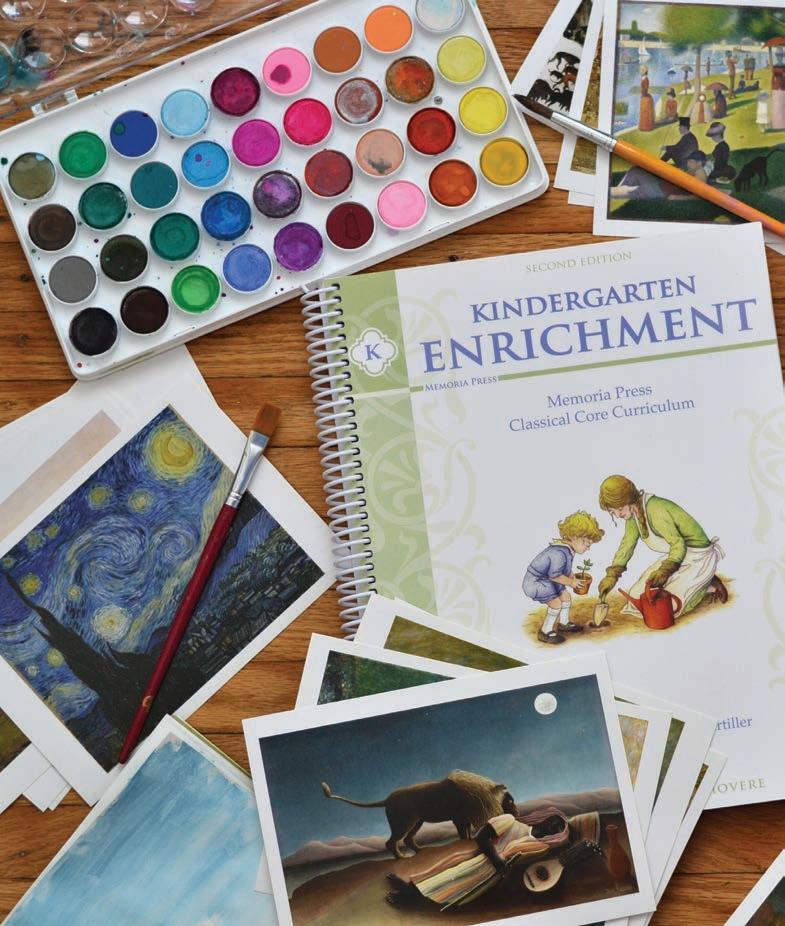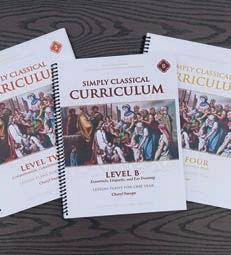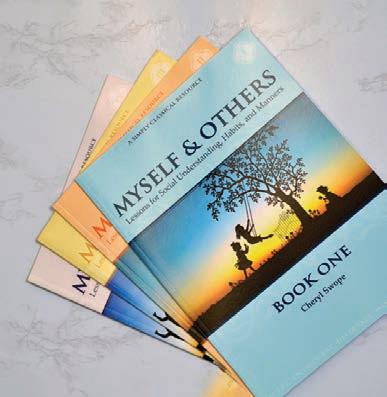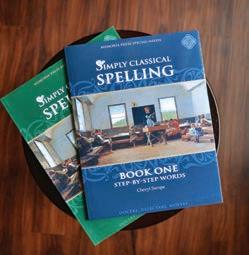
11 minute read
Primary Enrichment
Enrichment Guides
Classical Core Curriculum supplement (Kindergarten, 1st Grade, or 2nd Grade) $19.95 ea. ese supplemental guides coordinate with our Classical Core Kindergarten, First Grade, and Second Grade programs. Each guide includes an overview of each read-aloud book, author and illustrator biographies, oral reading questions, and a simple language lesson, as well as resources for the history, culture, and science lessons, biographies of the artists, and poetry lessons.
Music Enrichment
Classical Core Curriculum supplement Grades K-2 | $12.95 Music Enrichment goes into more detail about each song studied in our Enrichment Guides, including a short backstory on each song and its composer, as well as a few interesting facts and discussion questions.
e Book of Crafts
Classical Core Curriculum supplement Grades Jr. K-2 | $16.95 ea. e creative arts are an essential part of primary school education. ese activities reinforce number and letter recognition, strengthen ne-motor skills, and foster creativity and con dence. ere is a craft project for each read-aloud in Memoria Press' Jr. K-2 curriculum packages, and additional crafts that focus on art concepts. Enjoy each of your creations and the time spent together making them.
Cut & Paste Book
NEW
Classical Core Curriculum supplement | $6.00 Students will practice scissors skills while working on mastery of beginning phonics sounds.
Scissors Books
Classical Core Curriculum supplement My Very First Scissors Book $6.00 My Very Own Scissors Book $6.00 Help your student develop hand strength, ne-motor skills, and independence with one or both of these books.
Character Building
Myself & Others
Lessons for Social Understanding, Habits, & Manners by Cheryl Swope Ages 4-13
Guide Books $19.95 ea. Book One Core Set $56 | Book One Read-Aloud Set $100 Book Two Core Set $22 | Book Two Read-Aloud Set $99 Book ree Core Set $55 | Book Four Core Set $48
Manner of the Week Wall Charts
11" x 8.5" Grades K+ | $14.95 NEW Be respectful, listen carefully, look for opportunities to include others, chew with your mouth closed—these simple, thoughtful guidelines for good manners are a great visual aid for your classroom or homeschool. Includes 34 wall charts, one for each week of your school year.
First Start Reading: Phonics, Reading, & Printing
Grade K | by Cheryl Lowe
$45.95 set (Books A-D + Teacher Guide) Student Books (A-D) $7.00 ea. | Teacher Guide for Books A-D $17.95 Your children can begin reading instantly as they progress through 5 simple student books and 34 phonetic stories. e Teacher Guide includes helpful assessments, tips, and more! • consonants • short & long vowels · 57 common words · artist-drawn coloring pictures · manuscript printing · drawing pages for every letter FSR is a balanced, age-appropriate approach to phonics and reading, with a serious focus on correct pencil grip and letter formation. Also, while many phonics programs today use the ladder approach (consonant-vowel blending), we prefer the more traditional (vowel-consonant) approach combined with word families. Mastery of short vowels is the sine qua non of phonics programs, but few programs provide adequate practice. e FSR kindergarten program consists of 4 student books with artist- drawn pictures to color, drawing pages for each letter or phonogram, and over 30 stories. e Teacher Guide leads you through the program and provides helpful assessments and teaching tips.
*Note: Printing, an important pathway of the learning process, is an integral part of FSR. Some children, however, are reading-ready before their motor skills are developed enough for printing. If this is the case with your child, you may use FSR without the printing component.
Kindergarten Phonics & Reading Set
Grade K | $180 set Everything you need to teach your student to read uently, including lesson plans!
Alphabet & Coloring
Alphabet Book Part One & Part Two
by Leigh Lowe
$30 set (2 books) Recommended for Ages 4-5 Teaches letter recognition, letter formation, and pencil grip. is is a gentle introduction to phonics.
Numbers & Colors
Recommended for Ages 4-5 $15.00 Introduces color words and each number through 15.

$55.00 Let primary specialist Michelle Tefertiller teach your students how to read! ese streaming videos use all the books in the Kindergarten Phonics & Reading Set.
Coloring Books
Recommended for Ages 4-5 Numbers $6.00 Alphabet $6.00
Alphabet Flashcards
(4¼'' x 5½") $10.00
First Start Reading, Book E
by Michelle Tefertiller Grade 1 Student Book E $7.00 Teacher Guide for Book E $9.95 We complete our phonics for reading program at the beginning of rst grade with First Start Reading Book E. After students have completed Books A-D in kindergarten, they are ready for the long vowel teams, sounds of soft c and g, and the three sounds of y in Book E. Once the student has mastered the basic phonics in the FSR series, he is ready to continue reading progress with real literature, and continue his phonics studies with Traditional Spelling.
100 Days of Summer Reading Books I-III
Grades K-2 $7.95 ea. Reading is a subject that should continue through the summer to avoid regression. ese summer reading journals are a perfect way to encourage young children to continue working on reading uency. e font size gets smaller for each journal, and each page is divided in half for drawing and writing small summaries. Kindergarten has the unique goal of reading a book a day for 100 days!
Classical Phonics
by Cheryl Lowe Grades K-2 $16.95 ese phonetically arranged word lists require students to rely on their mastery of letter sounds. Coordinates with First Start Reading, or is a good supplement to any phonics program.
Phonics Flashcards
Grades K-2 (4¼'' x 5½") $24.95
Flashcards for the nearly 200 phonograms used to spell the 44 sounds of the English language.
Easy Reader Classics
Grades K-2 $65 set (18 books) | $3.95 ea. Classic stories from e Jungle Book, e Wind in the Willows, Tom Sawyer, and Doctor Dolittle have been adapted in these early readers so young children can read good stories on their level. Simple sentences and beautiful illustrations are a perfect t for primary students who are ready to practice reading uency.
Spelling
Phonics from A to Z
$27.99 A manual for teachers who want to go deeper into the subject of phonics and reading.
Teaching Phonics & Word Study
$33.99 An excellent phonics resource for grammar school teachers.
My child learned to read using [First Start Reading]. It has enjoyable activities as well as assignments that train in discipline and diligence. —M.M.
Traditional Spelling I & II
(Traditional Spelling I shown) by Cheryl Lowe Grades 1-2
$48 set ea.
(student, teacher, practice sheets, supplemental workbook, supplemental workbook key)
Student $14.95 ea. | Teacher $16.95 ea. Practice Sheets $5.00 ea. Supplemental Workbook $7.95 ea. Supplemental Workbook Key $7.95 ea. is comprehensive, phonetic approach to teaching spelling is the culmination of our primary Phonics & Reading program. It is designed to follow completion of the Kindergarten Curriculum Package or First Start Reading Books A-D, which ensure students have mastered reading "consonant-vowel-consonant" words with short vowels. Paired with StoryTime and More StoryTime Treasures in rst grade, or with the literature study guides in second grade, Traditional Spelling provides your student with an extensive mastery-based study of phonics for spelling and reading. Each four-page lesson features writing and oral dictation practice, color-coded phonogram activities, and short stories on the student's reading level that utilize that week's spelling words.
TEACHING THE FAITH WITH SPECIAL NEEDS
by Cheryl Swope
When teaching the faith to children with special learning needs, begin with Bible stories depicted by the most beautiful illustrations you can find. Bible stories introduce us to God who is fiercely holy and righteous while also merciful, compassionate, and true to His promises. Bible stories are the bedrock of biblical literacy. Before a child can read the Holy Scriptures for himself, he can hear stories. Before a child can comprehend doctrine, he can hear stories. Before he can express his faith with eloquence, he can hear stories.
Biblical literacy begins with the very personal names, places, and events of biblical historicity: Creation spoken into existence in the Garden of Eden Adam and Eve cast out due to sin and promised a Savior Noah and his family mocked by others but preserved by the L in the Ark.
Bible Stories

We encourage multiple readings of Bible stories. In our home we sought reliable texts from Holy Scripture or with wording as close to the Scriptures as possible. Then we read each version from start to finish. We desired realistic sacred art within the volumes. It was important to me that my children did not see frivolous depictions, but instead that any illustrations conveyed the comforting assurance that these stories are as real as any other we teach from history.
At Memoria Press we introduce children to Jesus through age-appropriate books and simple, daily lessons. We begin with Jesus, for "He is before all things, and by him all things consist" (Colossians 1:17).
Older Students and Teens
In a Christian school, Sunday school, homeschool group, or confirmation class you
Cheryl Swope is the author of Simply Classical: A Beautiful Education for Any Child and Memoria Press' Simply Classical Curriculum, as well as editor of the Simply Classical Journal. will find a mix of students with varying degrees of biblical literacy and faith instruction. A pastor recently asked me if I had any suggestions for teaching catechesis or confirmation class materials to a young person with special needs.
It breaks my heart that with as many as one in five children facing significant learning challenges, many churches do not yet have confessional materials available to them for teaching the faith to young people with special needs. I told the pastor that one-on-one tutoring may be needed for some things, but that he should consider including the student for group instruction whenever possible. I offered him suggestions in several areas. Acceptance: At the beginning of each class, set the tone by praying with thanksgiving for every student present. Acknowledge that each is fearfully and wonderfully made in the image of God. Give thanks that the L desires all to come to salvation. Give thanks that the Church is a body made of many and varied members. Pray for all to have patience, wisdom, and forbearance with fervent love toward one another.
Memory Work: If necessary, require that the student memorize only one key verse per tenet of the faith or catechism. Provide memory verses in advance. Even if a student's memory work must be abbreviated, lead group recitations with full verses displayed in large manuscript font on flip charts or on the board for all to hear and see, as "faith comes by hearing, and hearing by the Word of God" (Romans 1 :17).
Bible Stories: If biblical literacy is lacking, read sequentially through one or two Bible stories at the beginning of each class period. Send home readable versions for students who need them.
Prayer: uring corporate prayers, encourage all students to pray along silently. o not call on your
struggling student to pray aloud extemporaneously if he is not adept at oral expression. You might assign him a brief prayer to practice at home if he must pray aloud individually.
Hymns: When students learn new hymns, teach the refrain first. Teach stanzas through call and response. iscuss meanings of words. ocus on one or two hymns to learn thoroughly by heart. Think multum non multa (much not many). When teaching additional hymnody or liturgical elements, encourage all students to listen, sing, and follow along to the greatest extent possible.
Visual Aids: isplay wall maps. Supply flashcards of key memory verses. Provide printed outlines for taking notes in class or send home questions for completion prior to class to allow for improved attention during class. isplay select sacred art posters for teaching about the Creation, the all, the Incarnation, and the Church. isplay posters of the Ten Commandments, the Apostles' Creed, and the Lord's Prayer for daily group review if any student does not yet know these.
Re ec on: se resources for directed reflection (such as My Thankfulness Journals) to encourage devotional reflection. Especially for students with special needs, the teen years can become fraught with destructive self-pity if not guided toward more suitable, edifying, and hopeful thankfulness each day. Allow oral or scribed responses if necessary.
Support: If a parent, aide, sibling, or grandparent is available to take notes or otherwise reduce obstacles for a student with special needs, consider allowing the support person to attend classes quietly.
Fellowship: While a tutorial approach for catechizing and practicing at home may work well, even students with social challenges will appreciate being part of a welcoming class for Christian fellowship.
Freedom to Adapt
o not fret about providing accommodations for a student who needs them. If the student were in a wheelchair, we would build a ramp to the church or we would carry him to Jesus our "ramp" will be of threefold construction: teaching one-on-one where needed, ensuring biblical literacy, and welcoming the student with any necessary supports to impart the eternal, communal benefits of the Christian faith.
Embrace the challenge. Students with special needs help us sharpen catechesis to the essentials. Let this refresh your teaching as you lead all students toward what is needful for forgiveness and fortification in Jesus Christ.
Nothing is more important.
"Whoever drinks of the water that I shall give him will never thirst. But the water that I shall give him will become in him a fountain of water springing up into everlasting life" (John :1 ).





Memoria Press works with schools all over the country to assist in understanding the vision of classical education and to help implement a cohesive classical curriculum. Cheryl Swope has oined forces with the Classical Latin School Association training team to help your school start or improve education for your struggling students and students with special needs.










